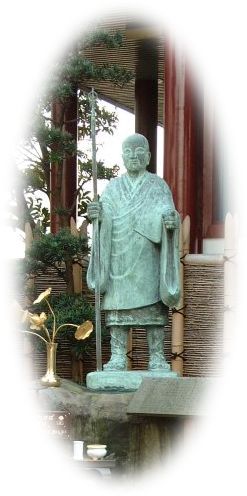
Statue of "Futatabi Daishi"
overlooking throughout Japan from Godaisan in Chugoku Region
(in front of Hozenin main temple) |
■ Introduction ■
|
About one thousand and several hundred years ago, Kobo-Daishi, or Kukai, crossed the sea to Changan, the Capital of Tang China, in a Kentoshi ship. It is so long ago that nobody knows where the honorable "Odaishisama" was before he traveled to Changan. Emerging from obscurity, his name abruptly appeared in the record of Japanese official "Kentoshi" delegate ships. There have been so many various theories regarding Odaishisama's achievements before his entry into Tang that this period is thought of as a blank period, or a time of mystery, in the life of
Kobo-Daishi.
One night, a Buddhist priest Hozenin Koko received a divine revelation, in which he knew that during this mysterious period, Odaishisama secretly traveled to China for ascetic practice. Priest Koko delivered his argument of the "Kobo-Daishi Twice to China Theory" widely to the public, and produced a statue of Daishi to tangibly represent the prophetic dream. The statue was constructed at the top of "Godaisan," a sacred mountain for the Chinese esoteric Buddhism, overlooking across the country there from.
In admiration of Odaishisama's traveling twice to China through long, rough sea voyages as far back as one thousand and several hundred years ago, Priest Koko named the statue "Futatabi Daishi" (meaning, "again Daishi"). Whatever wish visitors may have in mind, they would sense the miraculous virtues as they pray to the "Futatabi" statue.
This study is a modified version of the paper presented in the "Rokudai Shinpo" journal by the author at the age of 33 in 1977. |
Ryuko Matsushita
Hozenin 24th, Fukushosan
July 2005 |